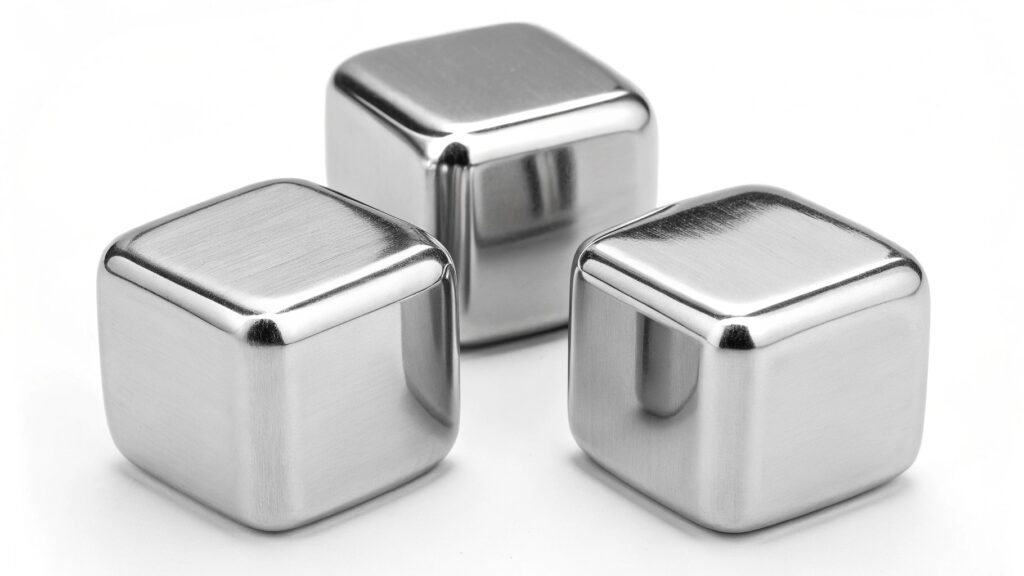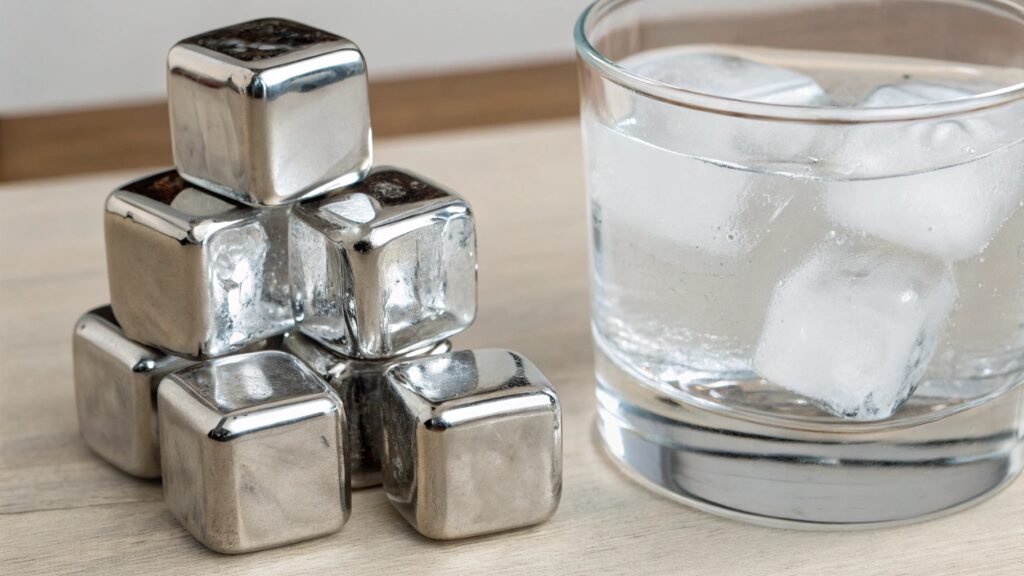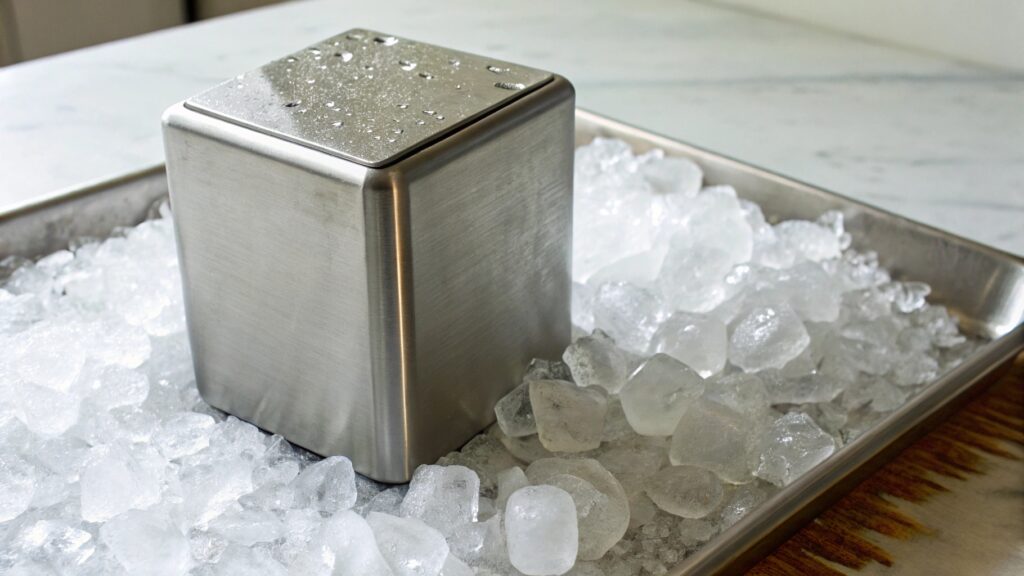How Do Stainless Steel Ice Cubes Work?
Tired of watered-down drinks ruining your perfect beverage? There's a sleek, sustainable solution. Discover the magic behind stainless steel ice cubes.
Stainless steel ice cubes work by using a frozen, food-safe gel or liquid sealed inside a non-porous metal shell, which quickly chills drinks without melting, preserving the beverage's undiluted flavor and temperature.

You might wonder how a piece of metal can keep your drink cold without melting like ice. I have seen many people surprised by their simple effectiveness. It's a clever blend of engineering and a nod to modern values.
Are Stainless Steel Ice Cubes Effective?
Skeptical if metal cubes can truly chill your drink like ice? Many wonder about their real cooling power. Let me explain their effectiveness.
Yes, stainless steel ice cubes are highly effective for chilling beverages, especially those where dilution is undesirable, providing a sustained cool temperature without altering the drink's original flavor or strength.

The effectiveness of stainless steel ice cubes1 comes down to their thermal properties2. Unlike traditional ice, which undergoes a phase change (melting from solid to liquid) to cool a drink, stainless steel cubes absorb heat from the liquid. This process keeps the drink cold without adding any water. Most cubes contain a non-toxic freezing gel inside, which helps them stay cold for a longer time than solid stainless steel alone. This design allows for a more consistent and prolonged cooling effect. I often recommend these to clients who want to offer a premium gifting experience, especially for those who appreciate fine spirits or cold brew coffee. I have personally used these cubes for my morning cold brew, and I find that my drink stays perfectly chilled from the first sip to the last, without becoming weak. This sustained chill is a key benefit, especially for drinks meant to be savored.
| Feature | How It Contributes to Effectiveness | Benefit for Drink |
|---|---|---|
| Internal Gel | Retains cold longer than solid metal | Prolonged chilling effect |
| High Thermal Conductivity | Rapidly transfers cold to liquid | Quick cooling action |
| Non-Melting | No water added to the drink | Preserves original flavor and strength |
| Reusable | Consistent performance over many uses | Reliable chilling solution |
What Are the Disadvantages of Stainless Steel Ice Cubes?
Considering stainless steel ice cubes but worried about potential drawbacks? Every product has its limitations. I can help you understand them.
While highly effective, stainless steel ice cubes have some disadvantages, including a slower initial cooling rate3 than traditional ice, the need for freezer space, and potential for clinking against glassware, which can be mitigated with proper use.

Even though I am a big advocate for stainless steel ice cubes, it is important to understand their limitations. One main point is their initial cooling speed. Traditional ice, because it melts, cools drinks very quickly due to latent heat transfer. Stainless steel cubes, by not melting, transfer heat slower at first. This means your drink might take a little longer to reach its desired coldness. Another common concern is the potential for them to clink loudly against glasses, especially thinner ones. This can be jarring and might even chip delicate glassware. To avoid this, I always suggest using them with sturdy glasses. Also, they take up freezer space, and you need to remember to refreeze them after each use. This is a small trade-off for their reusability. For instance, I once forgot to put them back in the freezer after a gathering, and the next morning, they were not ready when I wanted my chilled coffee. It shows that they require a bit of planning, unlike simply making more ice.
| Disadvantage | Explanation | How to Mitigate |
|---|---|---|
| Slower Initial Chill | Relies on heat absorption, not melting | Freeze longer, use more cubes for faster cooling |
| Potential for Clinking | Hard metal against glass | Use with sturdy glassware, drop in gently |
| Requires Freezer Space | Needs freezing time and dedicated space | Plan ahead, store in a small bag or tray |
| No Dilution (Pro/Con) | Preserves flavor, but some prefer slight dilution | Not suitable for drinks meant to be diluted |
How Does Stainless Steel Melt Ice?
Ever wondered how a metal cube, which isn't melting itself, can impact the ice around it? The interaction might surprise you.
Stainless steel does not melt ice; instead, it efficiently transfers its stored coldness to the surrounding liquid and any ice present, effectively helping to cool the drink while delaying the melting of traditional ice by maintaining a lower ambient temperature.

This question often comes up, and it is a common misunderstanding. Stainless steel itself does not melt ice in the same way that a warmer object would. Instead, the frozen stainless steel cube acts as a cold reservoir. When you place a frozen stainless steel cube into a drink that also has traditional ice, the stainless steel cube absorbs heat from the liquid and the surrounding environment, including any ice. By keeping the overall temperature of the drink colder, the stainless steel cube effectively slows down the melting process of the traditional ice. It helps to maintain the chill for a longer period. Think of it this way: the stainless steel cube is doing part of the cooling work, reducing the burden on the traditional ice to melt and cool the drink. This allows the traditional ice to last longer before fully melting and diluting your beverage. I have noticed this effect when I use a few stainless steel cubes alongside regular ice in a cocktail; the regular ice seems to last much longer.
| Process Involved | Role of Stainless Steel Cube | Impact on Ice |
|---|---|---|
| Heat Absorption | Takes heat from the liquid and ice | Reduces melting rate of traditional ice |
| Temperature Maintenance | Keeps the overall drink colder | Prolongs the life of traditional ice |
| No Phase Change | Does not melt itself | Prevents further dilution of drink |
| Thermal Transfer | Efficiently moves coldness to liquid | Ensures consistent, long-lasting chill |
Conclusion
Stainless steel ice cubes are effective, reusable tools that chill drinks without dilution. While they have minor drawbacks, their benefits for preserving flavor and promoting sustainability are clear.
-
Explore this link to understand the science behind stainless steel ice cubes and their chilling effectiveness, enhancing your beverage experience. ↩
-
Learn about the thermal properties that make stainless steel ice cubes effective at cooling drinks without dilution, perfect for beverage enthusiasts. ↩
-
Discover the differences in cooling rates between stainless steel and traditional ice, helping you choose the best option for your drinks. ↩





